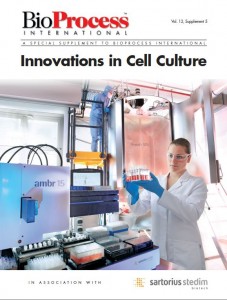 This special issue has come about through a long collaborative process with our contacts at Sartorius Stedim Biotech in Göttingen, Germany. It is the third such sponsored issue that BPI has published over the years with the company and the first one that we have produced in-house. We could not be happier with the results.
This special issue has come about through a long collaborative process with our contacts at Sartorius Stedim Biotech in Göttingen, Germany. It is the third such sponsored issue that BPI has published over the years with the company and the first one that we have produced in-house. We could not be happier with the results.
The aim here is to highlight technologies and responses to key industry challenges rather than focus over much on Sartorius itself. But the company’s long-standing culture of developing its own and integrating acquired technologies and processes — toward its goal of providing total biomanufacturing solutions — is worth underscoring. In the two interviews in this issue you will read about a company that has a long history of investing in and positioning its technologies and related equipment for future needs, even when the current industry has not been quite ready for them yet. In this risk-averse era, such long-term thinking can require no small amount of corporate courage. Through its own R&D activities and combinations of licensing, partnering, and acquisitions the company has crafted its current identity and continues on a well-defined path.
As part of this issue’s preparation, BPI publisher Brian Caine and I traveled to the Sartorius Stedim Biotech facility in Göttingen, Germany. There we interviewed Christel Fenge (vice president of marketing for fermentation technologies), Reinhard Vogt (executive vice president of marketing, sales, and services and a member of the administrative board), and Stefan Schlack (senior vice president of marketing and product management). Brian and I were grateful for the time they devoted to speaking with us — all during a very busy few days. That week the company was also conducting a two-day conference at its Sartorius College. Academic and industry speakers presented analyses of PAT tools and how those can enhance process modeling and development under the quality by design (QbD) initiative. That event highlighted Sartorius Stedim Biotech’s commitment to educating and training the coming generations of bioprocessors.
Our general theme here is the development and continual optimization of upstream technologies, so articles related to fermentation issues and to development and design of single-use bioreactors make up the first half of this supplement. This continues BPI’s exploration of the present and future viability of single-use technologies (highlighted recently in our April supplement). The ultimate goal for many industry insiders is to put together a completely single-use process from production through formulation, fill, and finish. Certain assurances need to be brought to the industry at large regarding one-time use of production and processing equipment. For one thing, what are these materials, really? This is a topic of increasing interest among our readers: how plastic materials and components are made and how companies are ensuring supply-chain consistency and robustness.
Herein you’ll find Sartorius Stedim Biotech’s solution to that particular concern — forming the second half of this issue. The company is providing and qualifying its own film by a strong cooperation with its partner, Südpack, and is taking control of associated risks in material suitability, reliability, and availability (sourcing of raw materials). Some articles in this issue explain the intricacies of that process.
Among products highlighted in these articles and interviews is the company’s new bag tester. Proper handling of single-use materials is another common theme these days. Users want to prevent leaks and tears as well as ensure bag compatibility with the products that come into contact with them. The bag tester is yet another element of the company’s goal to provide total solutions to its customers. Along with a focus on training, offering clients such a tool should increase confidence in adoption of single-use systems overall.
The topic of scalability is often the proverbial elephant lounging in the back of the room at single-use conferences. How large can single-use bags go? The consensus in this issue is that 2,000 L may be perfectly adequate, now that titers are higher and processes can be scaled to run in parallel. This is not the last word on the topic, of course, but a number of authors herein discuss reasons for that conclusion.
One of those reasons is that with Sartorius Stedim Biotech’s recent acquisition TAP Biosystems and its scalable line of ambr bioreactors, the company just doesn’t see the need for larger systems. Customers can use TAP systems to effectively optimize their processes and titers. Also, many larger companies still have stainless steel equipment to which they transfer processes for large-scale manufacturing — so questions remain in the industry about what biomanufacturing companies want and truly need at later processing stages.
Thus, authors in this issue are primarily examining bioreactor design innovations, qualification and GMP development, use of those bioreactors with the company’s line of Flexsafe bags, testing and qualification of the new film, and the status of sensor development. The latter will be an essential component for any totally single-use manufacturing operation in the future, when automation will be key. And although this issue focuses on upstream development, we conclude with an assessment of a single-use, filtration technology based on a diatomaceous-earth cell removal approach — just to take a quick look at the interface between upstream and downstream.
We thank the authors for contributing to this issue and for working closely with us to prepare their manuscripts for publication. We especially thank Sartorius Stedim Biotech’s corporate communications manager, Dominic Grone, who coordinated this project with us, circulated review copies to the authors, arranged for and helped us conduct the two interviews, and generally helped us keep track of the many pieces and multiple sets of expectations. This is truly a Sartorius Stedim Biotech product, and we enjoyed working with this company’s team to provide you with this publication.
